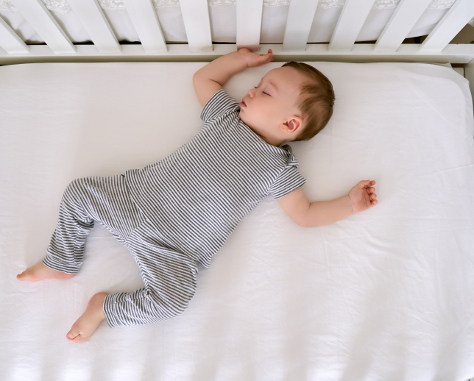Understanding your baby’s naps
Here’s what you can expect from your baby’s nap patterns

We know all babies develop differently and and at their own pace and this is no different when it comes to babies sleep patterns.
However, getting in to a recognisable pattern of naps during the day that works for you and your baby is a good way to avoid a grumpy baby and mum!
So here’s our guide to following your baby’s cues and getting into a healthy nap pattern.
Does my baby need a set number of naps?
You can never compare your little one with any other baby but you will probably notice over time that your little one falls into a pattern that works for them but there isn’t a set number that works for all.
Most newborns spend much of their day sleeping, in the first two weeks this can be as much as 20 hours a day! Once your little one gets a bit older, they may start to naturally get noticeably sleepy at certain points of the day. They need on average 12 to 16 hours of sleep daily until their first birthday so here’s a rough guide of how this might work:
Age 3 to 6 months: 3-4 naps a day
Age 6 to 9 months: 2-3 naps a day – some babies may be down to one nap in the morning and one in the afternoon – but some babies are happy having three or even four short cat naps.
Age 9 to 12 months: 1-2 naps a day 70-80% of babies are usually sleeping through- ie. They sleep 8-12 hours through the night without needing a feed.
Age 12 months to 3 years: Many still nap sat least once a day and over time they naturally get shorter and some children drop naps altogether by the time they’re 3 years old.
How long should I leave my baby to nap?
Quite often babies fall into one of two nap patterns, the “monster nappers,” babies who nap for two to three hours at a time, the “cat nappers,” babies who sleep for shorter periods —sometimes as little as 30 minutes a time.
It really doesn’t matter how your baby sleeps, it’s more important they are getting the number of hours sleep they need during the day. It’s a good idea to avoid late in the day sleeps that go on too long as this can interfere with their night time sleep.
How to establish good sleep patterns
Keep some things the same
To get into a pattern, it’s worth keeping some things consistent everyday such as the time you put them to bed, have mealtimes etc.
Think about where you’ll be
Your baby has more chance of a decent sleep if they are in a comfortable place to sleep. If your day can naturally work around the times they tend to sleep, it may be an idea to head home so they can sleep in their crib/Moses’ basket and they may sleep for longer giving you a bit of a break.
Don’t over pack your day
Packing too much into your day can mean it’s difficult for your baby to settle for sleep when they’re tired as you may not be in the same place for long enough. Give yourself and your little one a mixed day of being out and about as well as chilled time.
Recognise the cues
Look out for the signs that your little one is getting sleepy, some obvious ones include rubbing their eyes or getting a bit short tempered. It’s time to go down for a nap when they have droopy eyelids, yawning.
Cover the basics
When the essentials are covered, it’s much easier for your little one to fall asleep, so always make sure they have a clean nappy on and a full tummy.
Pick the right time
Ease your baby into naptime rather than take them in in the middle of play because it’s just going to upset them and not put them in the best frame of mind for sleep. Try getting them ready slowly, pull the blinds down, start reading a book, play calm music to help them start to feel sleepy.
Naps won’t replace a night’s sleep
Don’t be under the illusion your little one might sleep more at night by giving up naps during the day. You’ll just end up with an overtired baby who can’t sleep at all well.
When is my baby likely to drop from three naps to two and then to one?
As always, these things vary from baby to baby, but a general rule sees many babies dropping from three naps to two around six months, and as they hit their first birthday often will drop the second nap. They do tend to do this when they’re ready, so it’s worth following your baby’s lead on this.
When is my baby likely to drop naps altogether?
Usually between the ages of 3 and 4, your little ones will stop napping altogether. Around this time, bedtime should start to run a bit smoother as they should be more tired for a night’s sleep having had no sleep during the day. But some kids still fall fast asleep and take a nap after a busy active day until they’re 4 or even 5 years old.